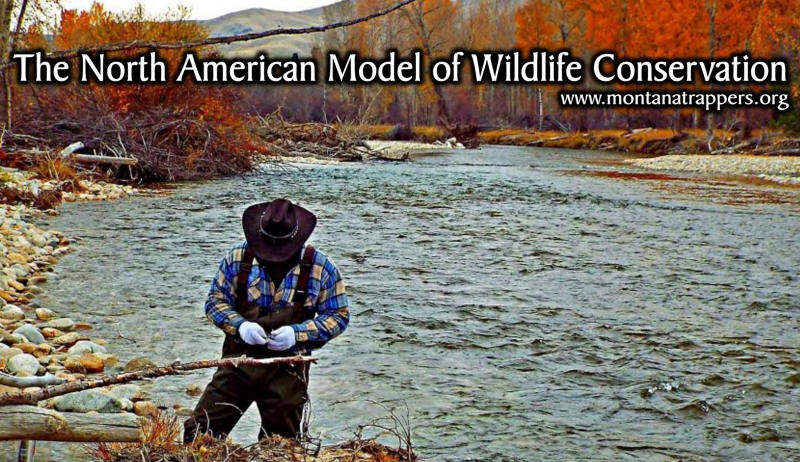
North American Model of Wildlife Conservation is a set of principles that has guided wildlife management and conservation decisions in the United States and Canada. Although not formally articulated until 2001, the model has its origins in 19th century conservation movements, the near extinction of several species of wildlife (including the American Bison) and the rise of sportsmen with the middle class. Beginning in the 1860s sportsmen began to organize and advocate for the preservation of wilderness areas and wildlife. The North American Model of Wildlife Conservation rests on two basic principles – fish and wildlife are for the non-commercial use of citizens, and should be managed such that they are available at optimum population levels forever.
Significance
The North
American model has no direct legal
powers, but rather has become the
basis for policies developed by the
Boone and Crockett Club, the
International Association of Fish
and Wildlife Agencies, The Wildlife
Society, and other conservation
groups. The model has been widely
accepted by wildlife professionals,
incorporated into U.S. state
agencies, and endorsed by
professional organizations and
teaching institutions.
Tenets
The
core principles of the Model are
elaborated upon in the seven major
tenets:
-
Wildlife as Public Trust Resources
-
Elimination of Markets for Game
-
Allocation of Wildlife by Law
-
Wildlife Should Only be Killed for a Legitimate Purpose
-
Wildlife is Considered an International Resource
-
Science is the Proper Tool for Discharge of Wildlife Policy
-
Democracy of Hunting
Wildlife as Public Trust Resources
In the North American Model,
wildlife is held in the public
trust. This means that fish and
wildlife are held by the public
through state and federal
governments. In other words, though
an individual may own the land up
which wildlife resides, that
individual does not own said
wildlife. Instead, the wildlife is
owned by all citizens. With origins
in Roman times and English Common
law, the public trust doctrine has
at its heart the 1842 Supreme Court
ruling Martin V. Waddell.
Elimination of Markets for Game
Commercial hunting and the sale
of wildlife is prohibited to ensure
the sustainability of wildlife
population. This principle holds
that that unregulated economic
markets for game and nongame
wildlife are unacceptable because
they privatize a common resource and
lead to declines. The Lacey Act of
1900 effectively made market hunting
illegal in the United States, and
the Migratory Bird Treaty Act of
1918 provided international
protections from the market.
Allocation of Wildlife by Law
Wildlife is allocated to the
public by law, as opposed to market
principles, land ownership, or other
status. Democratic processes and
public input into law-making help
ensure access is equitable. Laws
regulating access to wildlife
include the 1940 Bald and Golden
Eagle Protection Act, Endangered
Species Preservation Act and Fur
Seal Act of 1966, the Marine Mammal
Protection Act of 1972, and the 1973
Endangered Species Act.
Wildlife Should Only be Killed for a
Legitimate Purpose
Under the North American Model, the
killing of game must be done only
for food, fur, self-defense, and the
protection of property (including
livestock). In other words, it is
broadly regarded as unlawful and
unethical to kill fish or wildlife
(even with a license) without making
all reasonable effort to retrieve
and make reasonable use of the
resource.
Wildlife is Considered an
International Resource
As wildlife do not exist only within
fixed political boundaries,
effective management of these
resources must be done
internationally, through treaties
and the cooperation of management
agencies.
Science is the Proper Tool for
Discharge of Wildlife Policy
The North American Model recognizes
science as a basis for informed
management and decision-making
processes. This tenet draws from the
writings of Aldo Leopold, who in the
1930s called for a wildlife
conservation movement facilitated by
trained wildlife biologists that
made decisions based on facts,
professional experience, and
commitment to shared underlying
principles, rather than strictly
interests of hunting, stocking, or
culling of predators. Science in
wildlife policy includes studies of
population dynamics, behavior,
habitat, adaptive management, and
national surveys of hunting and
fishing.
Democracy of Hunting
This tenet is inspired by Theodore
Roosevelt's idea that open access to
hunting would result in many
benefits to society. The right to
hunt in the United States and Canada
by citizens of good standing is in
contrast to nations where hunting is
restricted to people with wealth,
land ownership, or other special
privileges. This tenet supports
access to firearms and the hunting
industry, of which much funding for
conservation is derived.
Criticism
Some authors
have questioned whether the North
America Model is inclusive of all
wildlife conservation interests or
exclusively narrow in its
application. The North American
model has also been criticized as
presenting an "inadequate history"
and prescribing "inadequate ethics"
of conservation, and in giving
recreational hunting
disproportionate credit for its role
in conservation. Critics say some
tenets are flawed or misguided, for
example that the tenet Elimination
of Markets for Game overlooks the
conservation success of Europe -
where wildlife is privatized and
commercialized - and ignores the
role of sustainable harvest
strategies, or that some hunting
activity may be inherently
contradictory to the tenet
Wildlife Should Only be Killed for a
Legitimate Purpose.



